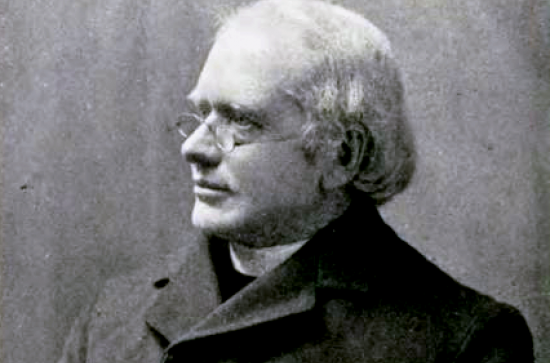“Mise an Mac San”: ag cuimhneamh ar an Athair Peadar Ó Laoghaire / “I am that Son”: Remembering an tAthair Peadar Ó Laoghaire
by Eilis and Pat O’Brien
(Eilis O’Brien, Ballard, Castlelyons, Co. Cork, Tel: O87-1235203; €15.00 + €8 p&p)
Of the few Irish priests who have achieved important literary fame, Fr Peadar O’Leary alone is widely read thanks to the adoption of his life story Mo Scéal Féin by the government as a school book in the Irish language courses.
To achieve this he had his active supporters. What was seen as his “exclusion from Irish education” was the theme of a pamphlet published in 1907.
He was not an uncontroversial figure: in the National Library there is a cartoon of him by the artist V. L. O’Connor showing Fr O’Leary leaping in the air and threatening a mild young man with a rather blunt meat cleaver. This is marked in pencil by the artist, ‘Dangerous not for publication’.
I never read O’Leary at school I have to confess. Our reading was Peig Sayers, Tomas O’Crohan and Maurice O’Sullivan. Of these I suppose O’Sullivan is the best, O Crohan next, and Peig a lesser third. However, those city folk who did read it at school whom I talked to over the years do not have happy memories of Mo Scéal Féin – it was dreary and sentimental: children can be unkind critics.
But such attitudes are perhaps now a thing of the past, though his famous book is out of print in both of our national languages, the last trade editions being back in the 1980s. More recently Edco had an school edition in Irish at €12.95, but this too they tell me is now unavailable. Readers should not be surprised: many of our national ‘classics’ are out of print.
Neglect
To remedy this neglect of a man and book of national interest two enthusiasts, connected with the parish of Castlelyons in Cork where O’Leary was for a long time the parish priest, have composed a bilingual book aimed at making the man himself as well known to the present day Ireland as his autobiography was to generations of Irish children in the past.
Fr O’Leary was a language activist whose great aim was to make Gaelic the spoken language of the land once again (though he declined to write for Pearse’s paper because he was too busy). To this end he wrote his own life as a text to provide both wholesome reading, a model of good Irish, and insight into the post-famine Ireland he grew up in.
It still retains its value for these reasons and will continue to do so. But those children who read the book as a text book rejected its sentimental view of Irish life. It is perhaps one of those books savagely satirised in sound Irish by Myles n Gopaleen in An Béal Bocht.
But such attitudes are perhaps a thing of the past. This book is written in the voice of Eilis O’Brien. It is not, as she admits a formal biography, but “my attempt at a portrait of an tAthair Peadar’s personality from the traces he left behind”, and as such it is full of interest.
But having established a chronology of his life and so many details about the latter part of his life, perhaps she should now be more ambitious and write a full biography. She works into the story the life of 1916 leader Thomas Kent, who was influenced by O’Leary, as well as a great many other personal recollections of those in the Castlelyons area or who were involved in the language movement who knew him.
While not following a strict chronological order, and written very informally, this is an enjoyable book for what it reveals not just about the national movement before 1916, but rural life in the 19th Century in contrast with rural life in the 20th Century.
O’Leary has already received attention from one eminent historian, who (the authors imply) was unkindly over-critical of O’Leary’s mistakes in his recollections which make them far from reliable.
But it has to be said that the forceful character of the man, and the strength of his views, about language , literature and Irish life come across very well here. The authors do not neglect his writings, but it is time that these too received a more formal treatment, relating them to the growth of Irish literature in both languages. It could be said that Séadna is the fons et origo of literature in Irish and that is certainly an achievement that has to be respected.
There are those who feel that grammarians have managed to stifle the creative fluidity of Irish as a literary medium. It was amusing then to read that at O’Leary’s funeral in 1920 the eminent scholar Osborn Bergin remarked: “Disgraceful!, that coffin plate contains seven grammatical errors.”
This biography is parochial in the real sense of the word, and all the better for it. Perhaps it will send readers back to Séadna and Mo Scéal Fein/My Story, and that would be a good thing too.


 Peter Costello
Peter Costello Peadar Ó Laoghaire
Peadar Ó Laoghaire 